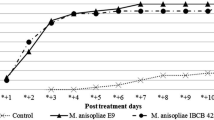Abstract
Entomopathogenous nematodes are well known biocontrol agents of insects. They live in the superficial layer of the soil, a location where ticks accomplish their molt and where they oviposit their eggs, making them, theoretically, the preys of infective larvae of nematodes. Seventeen strains of entomopathogenous nematodes: eight strains of Steinernema and nine strains of Heterorhabditis were placed in contact with each of the free living stages of three tick species: Amblyomma variegatum, Boophilus microplus and B. annulatus. The first two species were resistant to all the nematode strains that were tested, whereas B. annulatus was susceptible to all of them. Ovipositing females were more susceptible than females during the preoviposition period. There were no anatomical differences between the two species of Boophilus which can account for such differences in their susceptibility. The use of nematodes to control some species of ticks should be considered.
Similar content being viewed by others
References
BarréN., 1988. Mesures agronomiques permettant une diminution des populations de la tique Amblyomma variegatum. Rev. Elev. Méd. Vet. Pays Trop., 41: 387–393.
BarréN., MauléonH., GarrisG.I. and KermarrecA., 1991. Predators of the tick Amblyomma variegatum (Acari: Ixodidae) in Guadeloupe, French West Indies. Exp. Appl. Acarol., 12: 163–170.
BeddingR.A. and MolyneuxA.S., 1982. Penetration of insect cuticle by infective juveniles of Heterorhabditis spp. (Nematoda: Heterorhabditidae). Nematologia, 28: 354–359.
BlackshawR.P. and NewellC.R., 1987. Studies on temperature limitations to Heterorhabditis heliothidis activity. Nematologia, 33: 180–185.
CenturierV.C. and KlimaR. 1979. Ein beitrag zur kenntnis der Biologie von Amblyomma variegatum (Fabricius, 1974) Zeitschrift für angewwansdte Entomologie, 87: 131–142.
DaveyR.B., 1988. Effect of temperature on the ovipositional biology and egg viability of the cattle tick Boophilus annulatus. Exp. Appl. Acarol., 5: 1–14.
Diehl, P.A., Aeschlimann, A. and Obenchain, F.D., 1982. Tick reproduction: oogenesis and oviposition. In: Physiology of Ticks, F.D. Obenchain and R. Galun Ed. Pergamon Press, pp. 277–350.
FebvayG. and RahbéY., 1992. “Toxicologie”, un programme pour l'analyse des courbes de mortalité par la méthode des probits sur Macintosh. Cah. Techn. INRA, 27: 77–78.
GlazerI. and SamishM., 1993. Suitability of Boophilus annulatus replets females ticks as hosts of the nematode Steinernema carpocapsae. J. Invert. Pathol., 61: 220–222.
GeorgisR. and PoinarO., 1983. Vertical migration of Heterorhabditis bacteriophora and H. heliothidis (Nematoda: Heterorhabditidae) in sandy loam soil. J. Nematol., 15: 652–654.
Mracek, Z., Hazal, R. and Kodrik, D., 1988. Sites of penetration of juvenile Steinernematids and Heterorhabditids (Nematoda) into the larvae of Galleria mellonella (Lepidoptera). J. Invert. Pathol., 52.
MwangiE.N., DipeoluO.O., NewsonR.M., KaayaG.P. and HassanS.M., 1991. Predators, parasitoids and pathogens of ticks: a review. Biocontr. Sci. Techn., 1: 147–156.
Pavis, C., Mauléon, H., Barré, N. and Maibèche, M., 1993. Cuticular secretion of the tropical bont tick, Amblyomma variegatum (Acarina: Ixodidae): biological activity on predators and pathogens. In prep.
PoinarJ.O. and GeorgisR., 1990. Characterization and field application of Heterorhabditis bacteriophora strain HP88 (Heterorhabditidae: Rhabditida). Rev. Nematol., 13: 387–393.
SamishM. and GlazerI., 1991. Killing ticks with parasitic nematodes of insects. J. Invert. Pathol., 58: 281–282.
SamishM. and GlazerI., 1992. Infectivity of entomopathogenic nematodes (Steinernematidae and Heterorhabditidae) to female ticks of Boophilus annulatus (Arachnida: Ixodidae). J. Med. Entomol., 29: 614–618.
SolomonK.R., 1983. Acaricide resistance in tick. In: Advances in Veterinary Science and Comparative Medicine, Vol. 27, pp. 273–296 Academic Press, New York.
Stachurski, F., 1988. Impact économique actuel et interêt de l'éradication de la tique Amblyomma variegatum pour l'élevage bovin guadeloupéen. Thèse Doc. Vét. Créteil, 126 p.
Author information
Authors and Affiliations
Rights and permissions
About this article
Cite this article
Mauleon, H., Barré, N. & Panoma, S. Pathogenicity of 17 isolates of entomophagous nematodes (Steinernematidae and Heterorhabditidae) for the ticks Amblyomma variegatum (Fabricius), Boophilus microplus (Canestrini) and Boophilus annulatus (Say). Exp Appl Acarol 17, 831–838 (1993). https://doi.org/10.1007/BF00225856
Accepted:
Issue Date:
DOI: https://doi.org/10.1007/BF00225856




